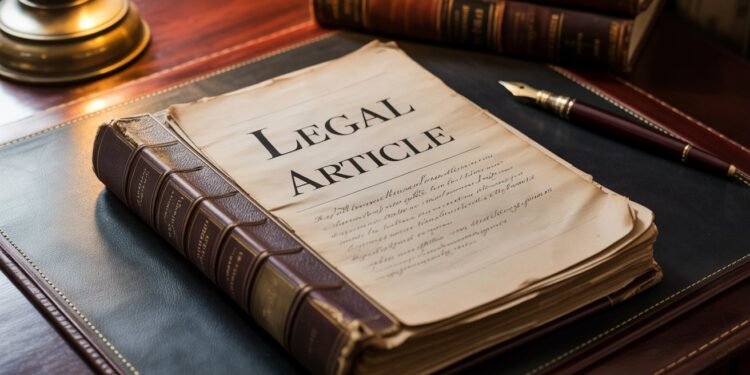Author: Archee samaiya, a student of Kle Society’s Law College, Bangalore
Abstract
The relation of law and religion in India has evolved through various complex judicial and constitutional developments. As a secular yet deeply religious nation, India guarantees freedom of conscience and religion under Articles 25 to 28 of the Constitution; however, this freedom is limited on grounds of public order, morality, and health. The judiciary has carved this domain through various doctrines, one of which is the ERP test, in an attempt to balance individual/group rights with constitutional morality. Key decisions like The Commissioner, Hindu Religious Endowments, Madras v. Sri Lakshmindra Thirtha Swamiar of Shirur Mutt (1954), Indian Young Lawyers Association v. State of Kerala (2018), and M. Ismail Faruqui v. Union of India (1994) have defined the contours of religious autonomy, the secular nature of the state, and the sanctity of places of worship. Further, the Places of Worship (Special Provisions) Act, 1991, the Bharatiya Sakshya Adhiniyam, 2023, and the property laws more often than not intersect with religious disputes over ownership, evidence, and identity of religious institutions. This article critically examines the ERP doctrine, the Places of Worship Act, and judicial interpretations for assessing the balance between religious freedom, equality, and secular governance.
Keywords: Essential Religious Practices, Religious Freedom, Secularism, Places of Worship Act, Constitutional Morality, Article 25, Judicial Interpretation, Evidence Law, Property Rights, Religious Autonomy.
Introduction
The constitutional vision of secularism in India relies on equal respect for all religions rather than complete separation between religion and state. Different from Western secularism, the Indian model focuses on neutrality and reform. Religion remains integral to the identity of millions and pervasive in personal laws, education, and culture.
The framers of the Constitution envisioned a society where faith and reason could coexist in perfect harmony with each other. Articles 25 to 28 of the Constitution accord freedom of religion, yet permit the state to intervene in non-essential or secular practices. This uneasy balance comes into play on issues like entry of women into temples, rights of religious minorities, and State intervention in temple administration.
The judiciary, while interpreting the ambit of religious freedom, has evolved the ERP test. Alongside, the Places of Worship (Special Provisions) Act, 1991 and subsequent judgments have entrenched the protection of religious structures to maintain communal harmony. Intersections at these constitutional and legal levels are valuable for understanding the dynamic interrelationship between law and faith in India.
- CONSTITUTIONAL FRAMEWORK GOVERNING RELIGIOUS FREEDOM
- Article 25: Freedom of Conscience and Religion
Article 25(1) gives every person the freedom to “profess, practice and propagate” religion subject to public order, morality, health, and other provisions of Part III of the Constitution. Thus, it balances individual liberty with social reform.
Article 25(2)(b) gives the state added authority to make laws for social welfare and reform, even if those laws interfere with religious custom, for example, the abolition of untouchability and temple entry legislation.
In the Indian case of Ratilal Panachand Gandhi v. State of Bombay, the Supreme Court held that religious freedom embraces not only the absolute freedom to profess one’s religion but the freedom also to exhibit and propagate it by words, acts, rites, and ceremonies.
- Article 26: Rights of Religious Denominations
Article 26, on the other hand, grants religious denominations the right to establish and maintain institutions and control their affairs regarding religion in conformity with public order, morality, and health. The Shirur Mutt case (1954) became the cornerstone in defining religious autonomy, with a holding of what constitutes an essential part of a religion to be determined by that very religion. But subsequent decisions often deviated from that, allowing courts to determine which practices qualify as essential.
- Articles 27 & 28: Economic and Educational DimensionsArticle 27 prohibits forced taxation to promote any religion, and Article 28 puts restrictions on religious instructions in state-funded institutions. Together, they uphold the secular character of the polity and allow religious freedom in private spheres.
- Evolution of the Essential Religious Practices (ERP) Test
- Origin in the Shirur Mutt Case
The ERP doctrine is the brainchild of The Commissioner, Hindu Religious Endowments, Madras v. Sri Lakshmindra Thirtha Swamiar of Shirur Mutt (1954), wherein the Supreme Court explained that religion includes “beliefs and doctrines which are regarded by the community as essential parts of their religion.” The Court made an anxious egotism to state that what is integral is prima facie for the religion itself to decide.
- Expansion and Judicial Control
Later, in Durgah Committee, Ajmer v. Syed Hussain Ali (1961), the Court, for the first time, narrowed the ERP test by holding that superstitious or extraneous practices not essential to religion could be regulated.[1] This marked the shift from deference to religious authorities toward judicial scrutiny.
- ERP in Contemporary Jurisprudence
In Indian Young Lawyers Association v. State of Kerala [2018] (Sabarimala Case), the Court struck down the ban on women aged 10-50 from entering the Sabarimala Temple, holding that exclusion was not an essential part of Hindu religion but a form of gender discrimination.[2]
Similarly, in Mohd. Hanif Quareshi v. State of Bihar (1958), the Court sustained the ban on cow slaughter, stating that it was not an integral part of Islam. These judgments illustrate how judiciary resorts to ERP while interpreting the balancing between religious freedom and other fundamental rights such as equality and dignity.
III. Religious Laws and Constitutional Morality
First explained in Navtej Singh Johar v. Union of India, the principle of constitutional morality works on the basis that the Constitution is supreme over religious and cultural norms if the latter violate fundamental rights. In Sabarimala, the Court resorted to constitutional morality to declare that faith cannot be burdened with exclusion based on gender. This thus constitutes a step toward recognizing equality and individual rights as paramount, over patriarchal or exclusionary traditions. Likewise, in Shayara Bano v. Union of India (2017), the practice of summary triple talaq was held to be unconstitutional because it violated gender justice and dignity under Article 14. Thus, constitutional morality acts as the link between faith-based practices and their acceptance within the constitution.
- The Places of Worship (Special Provisions) Act, 1991
- Background and Purpose
Enacted during communal unrest, Places of Worship (Special Provisions) Act, 1991 attempts to preserve the religious character of a place of worship as existed on August 15, 1947. Section 4(1) prohibits the conversion of a place of worship from one religion to another, and Section 4(2) forbids courts from entertaining related disputes.
The only exception is the Ram Janmabhoomi–Babri Masjid site in Ayodhya, which was already under litigation.
- Interpretation by the Judiciary
In M. Ismail Faruqui v. Union of India, the Supreme Court (1994) held that the Act was constitutionally valid as places of worship were necessary to be maintained for ensuring public order and communal harmony. (S. 12). It later held, in M. Siddiq (D) v. Mahant Suresh Das (2019), popularly known as the Ayodhya Judgment, that the Act plays an important role in upholding secularism and ensuring that religious disputes do not disturb the social fabric of this country.
- Current Challenges
Recent petitions before the Supreme Court have challenged the validity of the Act on the ground that it infringes upon the right to worship guaranteed under Article 25, but the state has justified it as a legislative tool for maintaining peace and continuity of history.
- Intersection of Religious and Property Laws
- Ownership of Religious Properties
There are normally controversies relating to temples, mosques, and churches regarding questions of ownership, management, and trusteeship. Similarly, Hindu temples’ administration can be regulated by the government under respective state Hindu Religious and Charitable Endowments Acts provided it does not interfere with the core religious rituals.
In Sri Adi Visheshwara of Kashi Vishwanath Temple v. State of U.P. (1997), the Court held that whereas the state can regulate ‘secular administration’, it cannot alter the essential religious character of an institution.
- Evidence Law in Religious Disputes
Under the Bharatiya Sakshya Adhiniyam, 2023 (in lieu of the Indian Evidence Act, 1872), evidence with regard to ancient religious usages, the owner of religious lands, and long-standing customs are admissible by oral, documentary, and expert evidence.
In a case like Ayodhya, historic documents, maps, and archaeological reports played an important evidentiary role in stating ownership and usage.
- Recent Judicial Developments and Debates
- Hijab Ban Case
In Aishat Shifa v. State of Karnataka, the Karnataka High Court had upheld the restrictions on hijab wearers in educational institutions by holding that wearing a hijab was not an essential practice of Islam.
The Supreme Court’s split verdict reflected continuing tensions in applying the ERP doctrine, where faith-based identity collides with uniform policies and state interests.[3]
- Gyanvapi Mosque Dispute
The Gyanvapi case in Varanasi represents the interplay between the Places of Worship Act and property law. Petitioners claim the mosque stands on a Hindu temple site, invoking Article 25 rights, while the Act bars such claims. The Supreme Court’s approach will likely influence the future interpretation of both the Act and secularism itself.[4]
- Uniform Civil Code Debate
The balance between religious autonomy and equality is further being debated with the debate over a Uniform Civil Code. However, while Article 44 does contemplate a common civil code, courts have often stressed that reform must not erode the essence of religious freedom.
VII. Critiques of the Essential Religious Practices Test
Critics, on the other hand, argue that the ERP test can allow judges who are not theologians to determine what is essential to a religion and that this could lead to inconsistency and subjectivity. Scholars like Gautam Bhatia argue that the test undermines religious autonomy by judicially defining faith.
Others argue for a rights-based approach, considering whether a practice violates constitutional rights rather than whether it constitutes an essential practice.
The Supreme Court itself has recognised the necessity of revisiting ERP in Sabarimala Review (2020), referring related questions to a larger bench.
VIII. Balancing Faith and Law: A Comparative View
“Hands-off” approaches, which avoid judicial interpretation of religious doctrines under the Free Exercise Clause of the First Amendment, are adopted by countries like the United States.
In contrast, India’s ERP test reflects its socio-legal context in which religion pervades public life and social reform often requires judicial intervention.
Success for Indian secularism depends upon keeping this balance-respect to faith, ensuring equality, and constitutional supremacy.
Conclusion
India’s legal and constitutional engagement with religion reflects a continuous conversation between faith, reform, and rights. The ERP test is flawed but remains an important tool of jurisprudence in making an assessment on religious claims. The Places of Worship Act, 1991, further consolidates the secular scheme of India by maintaining communal harmony.
As society evolves, religious freedoms will have to be interpreted by the courts through the prism of constitutional morality, which ensures that religion is not a license to exclude or discriminate. Balancing diversity, equality, and secularism remains the cornerstone of India’s constitutional promise: a secular state with a spiritual soul.



